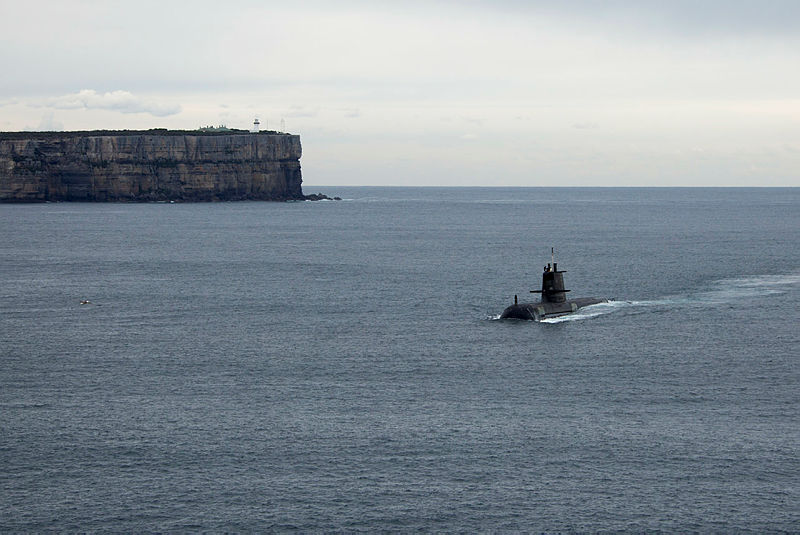
The latest salvo in the national debate about how best to spread the risks and benefits of the $300-billion naval shipbuilding plan is whether full-cycle docking of the Collins-class submarines should move from South Australia to Western Australia. It’s an important decision.
The Collins fleet is based in Perth. Although the boats were built by ASC in Adelaide, their ongoing sustainment involves four-yearly mid-cycle dockings that take place at HMAS Stirling and the Henderson shipyard in Western Australia. ASC has a total workforce of around 2,200 with around 280 positions in WA to do routine and mid-cycle sustainment work.
Major full-cycle dockings are required every eight to 10 years. They take two years to complete and can involve cutting open the submarine for a ground–up ‘nuts and bolts’ rebuild of hardware and systems. They are currently returned to the manufacturer, ASC at its Adelaide shipyard, where a highly skilled workforce reinvents each submarine.
WA has produced, and selectively released, reports which claim it’s in the ‘national interest’ to move the full-cycle dockings to Perth. There are hidden benefits for WA in its proposal. To cover the capability gap between the Collins-class and Attack-class fleets, there’s a multibillion-dollar plan to extend the life of possibly all six of the Collins submarines. If full-cycle dockings move to Perth, it’s probable the life-of-type extension would take place there too; and there’s more.
As ASPI’s Marcus Hellyer has noted, the government is yet to decide how the new Attack-class submarines will be sustained. If ASC is given that job, and if the company has in effect relocated to WA to support full-cycle dockings for Collins, then it’s highly likely that the 12 new submarines will also be sustained in WA. For every $1 billion spent building submarines, it’s generally accepted that around $2 to $3 billion is spent on sustainment. Defence is looking into the idea.
As luck would have it, Defence Minister Linda Reynolds, Defence Industry Minister Melissa Price and Finance Minister Mathias Corman all hail from WA. Attorney-General Christian Porter, another West Australian, is on the seven-member National Security Committee of Cabinet, which will make the final decision. No South Australians anywhere to be seen. The credibility of the full-cycle docking decision, and of the ministers, hinges on an outcome which is genuinely in the national interest, not just the political interest of the decision-makers. The process will be closely scrutinised.
Claims that assembling the skilled workforce, infrastructure and industry support required to both build and sustain submarines is beyond South Australia need to be balanced against similar competing pressures in WA caused by its existing fleet support and sustainment commitments and the prescient demands of recurring mining booms which tend to vacuum up skilled workers and resources wherever they can be found. SA needs to produce its own research to argue its case to ensure Defence is fully informed of the counterarguments and facts before the ‘Defence State’ misses the proverbial boat!
There is an alternative approach. In January 2017, I took to cabinet in SA recommendations from the Defence SA Advisory Board chaired by former defence force chief Angus Houston proposing that a national shipbuilding authority be established. The cabinet submission was supported by an authoritative 71-page report. We argued that the Naval Shipbuilding Advisory Board had been ineffective and that a more executive and enterprise focused body was needed to implement a coordinated national approach to the entire construction and sustainment cycle.
The nation’s aim must be to lift the Australian naval enterprise from a base level of maturity characterised by individual project decisions and an immature sovereign industrial capability to a dynamic best-practice model with minimal government control and ownership which looks at the entire task and is industry led. The report outlined a sustainable commercial structure for the next 50 years which optimised value for money and minimised risk with the entire shipbuilding enterprise at its core, not individual projects.
The proposal called for the creation of a national shipbuilding authority to report directly to the prime minister with an enterprise- and industry-focused executive board, a CEO and the authority to coordinate the national effort across government portfolios and agencies, across industry and the union movement, and across the higher education and vocational education sectors. The goal proposed was to ensure the effective delivery of both the operational and defence industrial capabilities the nation seeks. This would require a national balancing of the demands of construction, mid-cycle sustainment, full-cycle sustainment and fleet support across all ship types and programs with the nation’s workforce, and industrial and infrastructure bases for best effect.
Surely it’s better to be matching the entire national shipbuilding task with the whole of the nation’s capability to deliver, rather than to have the states arguing with the Commonwealth about who will do what with a particular part of a particular program. Unfortunately, an election and a change of government in SA followed this cabinet deliberation. The work seems to have sunk without a trace.
The social licence to spend such an enormous amount of taxpayers’ money on building warships depends on proving to Australians that the result will both defend the nation and strengthen its economy. A national shipbuilding authority could help deliver that outcome. The SA government would be well advised to refloat the report, release it for public discussion and take it to Canberra and to the Council of Australian Governments.

